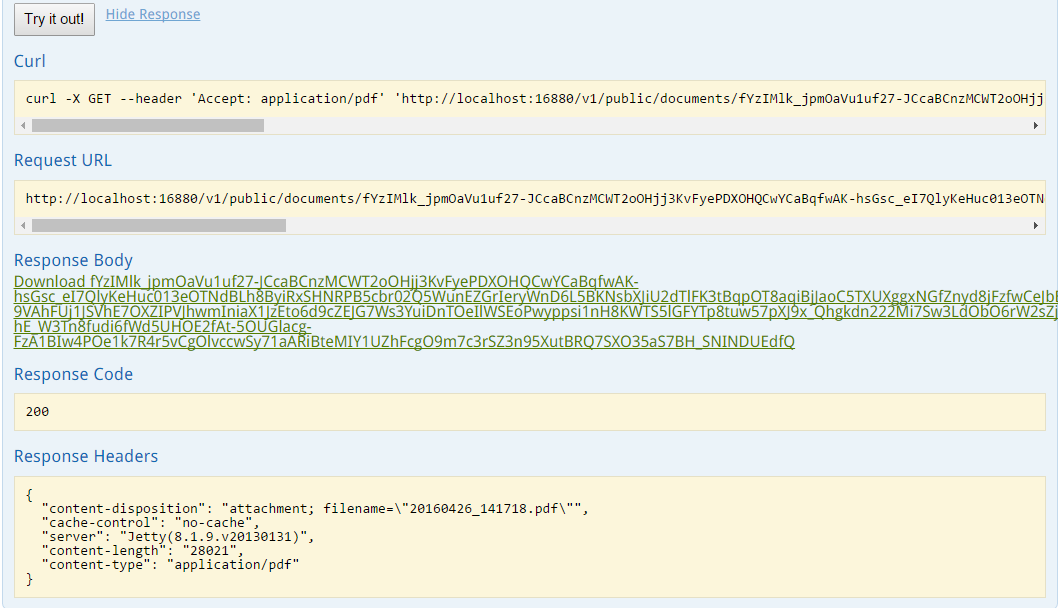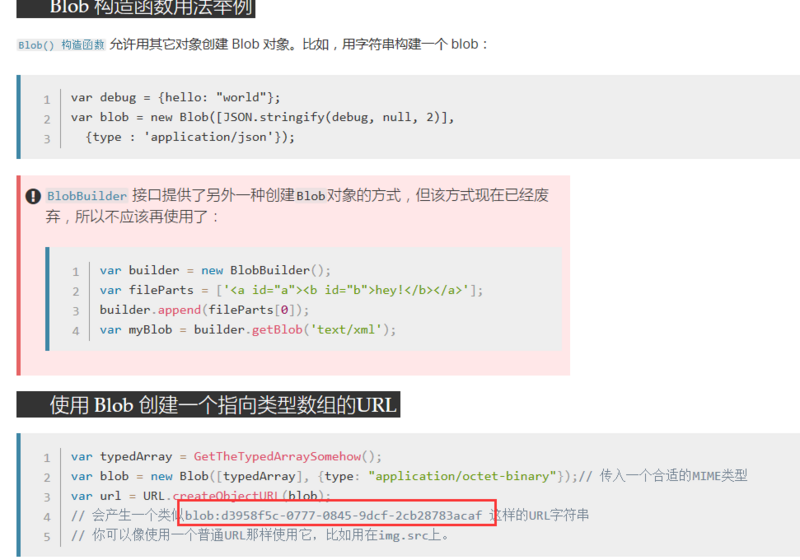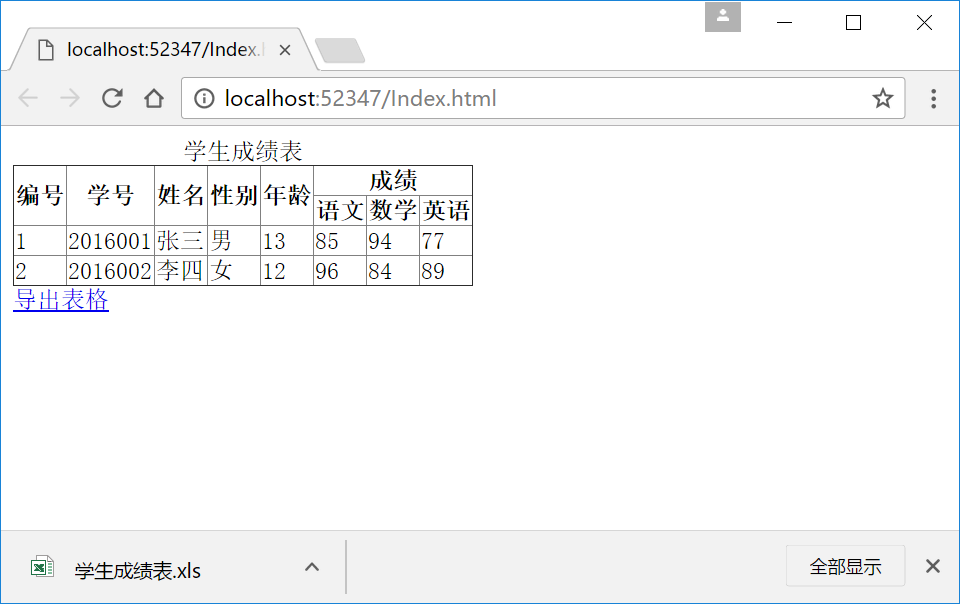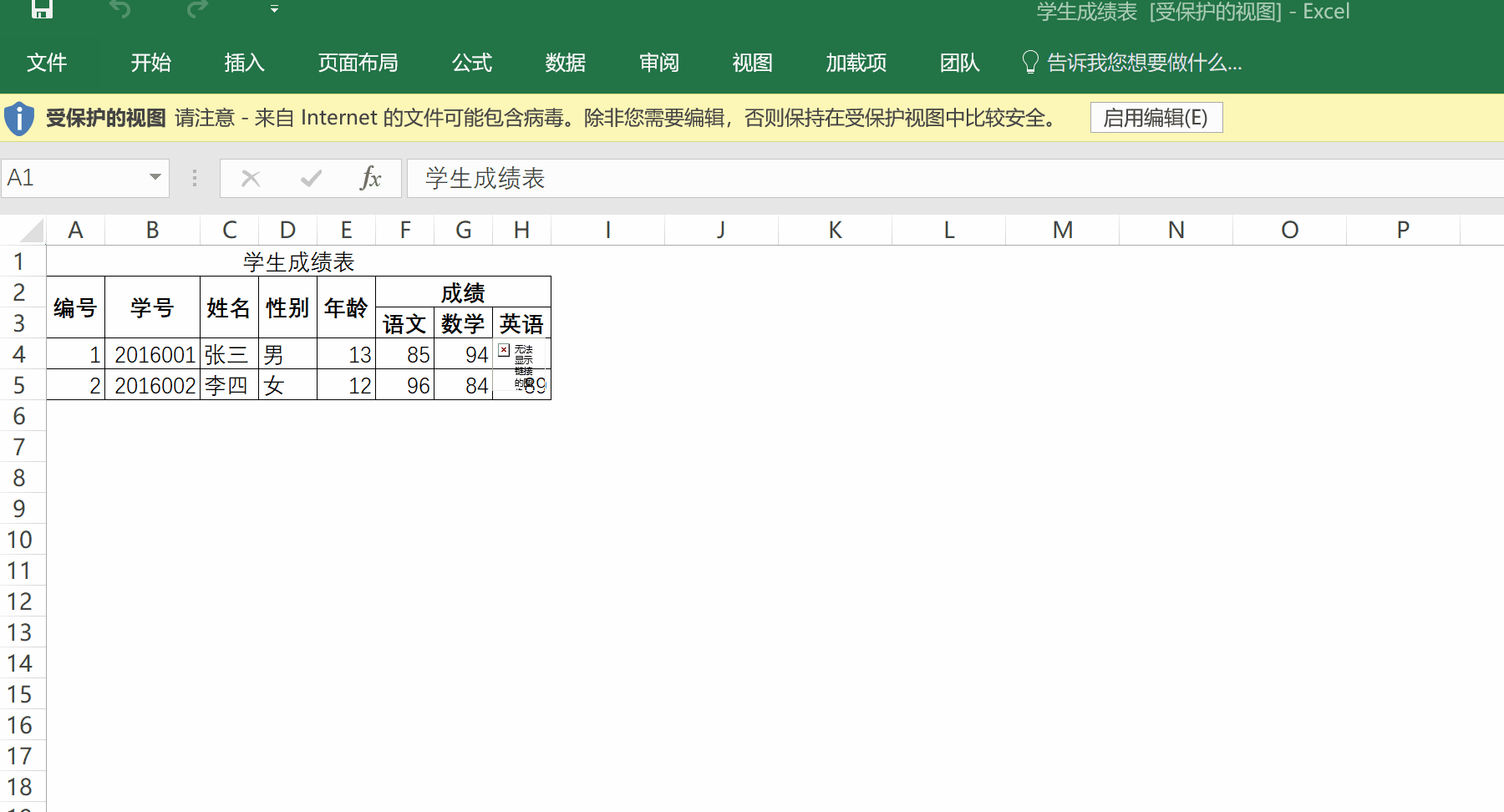I am having a problem similar to the ones described in #374 and #1196. I have a service which returns a pdf file as attachment with Content-Disposition header. This works when I call the endpoint from the browser - file is downloaded. On Swagger UI I get a download link after calling the service with response content type application/pdf, however that link downloads an empty pdf file:

My swagger.json is generated by Enunciate (version 2.3.0) and the relevant part looks like this:
"responses": {
"200": {
"schema": {
"description": "",
"$ref": "#/definitions/json_File"
}, ...
I tried adding "type": "file" to the schema, but it didn't fix the problem. What could be going wrong here?
https://github.com/swagger-api/swagger-ui/issues/2132
else if (headers['Content-Disposition'] && (/attachment/).test(headers['Content-Disposition']) || headers['content-disposition'] && (/attachment/).test(headers['content-disposition']) || headers['Content-Description'] && (/File Transfer/).test(headers['Content-Description']) || headers['content-description'] && (/File Transfer/).test(headers['content-description'])) { if ('Blob' in window) { var type = contentType || 'text/html'; blob = new Blob([content], {type: type}); var a = document.createElement('a'); var href = window.URL.createObjectURL(blob); var fileName = response.url.substr(response.url.lastIndexOf('/') + 1); var download = [type, fileName, href].join(':'); // Use filename from response header var disposition = headers['content-disposition'] || headers['Content-Disposition']; if(typeof disposition !== 'undefined') { var responseFilename = /filename=([^;]*);?/.exec(disposition); if(responseFilename !== null && responseFilename.length > 1) { download = responseFilename[1]; } } a.setAttribute('href', href); a.setAttribute('download', download); a.innerText = 'Download ' + fileName; pre = $('<div/>').append(a); } else { pre = $('<pre class="json" />').append('Download headers detected but your browser does not support downloading binary via XHR (Blob).'); }
https://github.com/swagger-api/swagger-ui/commit/4bdaeba797224bde922f3cefe55a6807428437a8
src="blob:http://" 这种链接格式是怎么做的
创建一个指向类型数组的URL,具体是做什么的我也看不太懂,官方api给你
blob的API:https://developer.mozilla.org/zh-CN/docs/Web/API/Blob
Blob 对象表示一个不可变、原始数据的类文件对象。Blob 表示的不一定是JavaScript原生格式的数据。File 接口基于Blob,继承了 blob 的功能并将其扩展使其支持用户系统上的文件。
要从其他非blob对象和数据构造一个Blob,请使用 Blob() 构造函数。要创建包含另一个blob数据的子集blob,请使用 slice()方法。要获取用户文件系统上的文件对应的Blob对象,请参阅 File文档。
接受Blob对象的API也被列在 File 文档中。
slice()方法原本接受length作为第二个参数,以表示复制到新Blob对象的字节数。如果设置的参数使start + length超出了源Blob对象的大小,那返回的则是从start到结尾的数据。slice() 方法在某些浏览器和版本上带有浏览器引擎前缀:比如 Firefox 12及更早版本的blob.mozSlice() 和Safari中的blob.webkitSlice()。 没有浏览器引擎前缀的老版本slice()方法有不同的语义,并且已过时。 Firefox 30 中取消了对blob.mozSlice()的支持。https://developer.mozilla.org/zh-CN/docs/Web/API/Blob
How to download a file in Swagger UI instead of displaying blob of text
If I enter the URL (http://localhost:13225/hellozip) in a browser the file is download in the usual way.
However if I navigate to the swagger ui and "Try it now" the response is a blob of text instead of downloading the file. Can you point out what I'm doing incorrectly. Thanks
[Route("/hellozip")]
public class HelloZip { }
public object Get(HelloZip request)
{
string tempPath = Path.GetTempPath();
string filePath = Path.Combine(tempPath, "HelloTest.zip");
base.Response.ContentType = "application/zip";
using (MemoryStream memoryStream = new MemoryStream())
{
using (var zipArchive = new ZipArchive(memoryStream, ZipArchiveMode.Create, true))
{
ZipArchiveEntry zipArchiveEntry = zipArchive.CreateEntry("Foo.txt");
using (Stream stream = zipArchiveEntry.Open())
{
using (StreamWriter streamWriter = new StreamWriter(stream))
{
streamWriter.Write("Bar!");
}
}
}
using (var fileStream = new FileStream(filePath, FileMode.Create))
{
memoryStream.Seek(0, SeekOrigin.Begin);
memoryStream.CopyTo(fileStream);
}
}
return new HttpResult(new FileInfo(filePath), true);
}
使用JavaScript把页面上的表格导出为Excel文件--使用了blob
如果在页面上展示了一个数据表格,而用户想把这个表格导出为Excel文件,那么在要求不高的情况下,可以不通过服务器生成表格,而是直接利用JavaScript的Blob和Object URL特性将表格导出。不过,丑话说在前头,这篇随笔中利用了Excel能打开HTML文档的特性,所以导出的表格实际上是一个HTML文档,并且其扩展名只能为.xls,而不能是.xlsx,否则Excel无法打开。(不过确实见过使用JavaScript生成真正Excel文件的方案,这里暂不提及。)
实现代码如下,包含HTML页面和JavaScript脚本:
<!DOCTYPE html>
<html>
<head>
<meta http-equiv="Content-Type" content="text/html; charset=utf-8" />
<title></title>
<meta charset="utf-8" />
<style>
/* 此样式仅用于浏览器页面效果,Excel不会分离表格边框,不需要此样式 */
table {
border-collapse: collapse;
}
</style>
</head>
<body>
<!-- 设置border="1"以显示表格框线 -->
<table border="1">
<!-- caption元素可以生成表标题,其单元格列跨度为表格的列数 -->
<caption>学生成绩表</caption>
<tr>
<!-- 可以使用rowspan和colspan来合并单元格 -->
<th rowspan="2">编号</th>
<th rowspan="2">学号</th>
<th rowspan="2">姓名</th>
<th rowspan="2">性别</th>
<th rowspan="2">年龄</th>
<th colspan="3">成绩</th>
</tr>
<tr>
<th>语文</th>
<th>数学</th>
<th>英语</th>
</tr>
<tr>
<td>1</td>
<td>2016001</td>
<td>张三</td>
<td>男</td>
<td>13</td>
<td>85</td>
<td>94</td>
<td>77</td>
</tr>
<tr>
<td>2</td>
<td>2016002</td>
<td>李四</td>
<td>女</td>
<td>12</td>
<td>96</td>
<td>84</td>
<td>89</td>
</tr>
</table>
<a>导出表格</a>
<script>
// 使用outerHTML属性获取整个table元素的HTML代码(包括<table>标签),然后包装成一个完整的HTML文档,设置charset为urf-8以防止中文乱码
var html = "<html><head><meta charset='utf-8' /></head><body>" + document.getElementsByTagName("table")[0].outerHTML + "</body></html>";
// 实例化一个Blob对象,其构造函数的第一个参数是包含文件内容的数组,第二个参数是包含文件类型属性的对象
var blob = new Blob([html], { type: "application/vnd.ms-excel" });
var a = document.getElementsByTagName("a")[0];
// 利用URL.createObjectURL()方法为a元素生成blob URL
a.href = URL.createObjectURL(blob);
// 设置文件名
a.download = "学生成绩表.xls";
</script>
</body>
</html>
效果如图:

打开下载的文件:

使用开发者工具检查a元素,就能大致明白blob URL的工作原理:
<a href="blob:http://localhost:52347/0ead79dc-1896-4a53-b1f1-dfbafff4e953" download="学生成绩表.xls">导出表格</a>
如果想通过按钮导出文件,可以在按钮的点击事件中创建a元素,配置其属性并触发其点击事件。不过在FireFox中,需要先将创建的a元素放入body中,否则无法下载。
https://www.cnblogs.com/zhuxinghan/p/6063193.html
启用编辑之后才会显示图片:
由于图片是链接,首先确保图片能被 excel 访问。
这个方法不完美,如果可以用更好的方法,还是不要用这个了。
<html> <head> <title>123</title> <SCRIPT LANGUAGE="javascript"><script> var idTmr = ""; function copy(tabid) { var oControlRange = document.body.createControlRange(); oControlRange.add(tabid, 0); oControlRange.select(); document.execCommand("Copy"); } function toExcel(tabid) { copy(tabid); try { var xls = new ActiveXObject("Excel.Application"); } catch (e) { alert("Excel没有安装或浏览器设置不正确.请启用所有Active控件和插件"); return false; } xls.visible = true; var xlBook = xls.Workbooks.Add; var xlsheet = xlBook.Worksheets(1); xlBook.Worksheets(1).Activate; for (var i = 0; i < tabid.rows(0).cells.length; i++) { xlsheet.Columns(i + 1).ColumnWidth = 15; } xlsheet.Paste; xls = null; idTmr = window.setInterval("Cleanup();", 1); } function Cleanup() { window.clearInterval(idTmr); CollectGarbage(); } </script> </head> <body> <input type="button" value="导入excel" onclick="toExcel(tt)"> <table border="1" id="tt" cellspacing="1"> <thead> <tr> <th colspan='7'> 基本信息 </th> </tr> <tr> <th>编号</th> <th class="strStaffCode">4564588</th> <th>姓名</th> <th class="strStaffName">张三</th> <th>性别</th> <th class="strSex">女</th> <th rowspan='2'> <img src="assets/img/picture-2.jpg" width="100" height="200" alt=""/> </th> </tr> <tr> <th>出生年月</th> <th class="strBirthday">1994-03</th> <th>籍贯</th> <th class=" strNativePlace">辽宁</th> <th>民族</th> <th class="strNation">汉族</th> </tr> </thead> </table> </body> </html>
https://www.cnblogs.com/zhuxinghan/p/6063193.html
关于Blob 前端下载文件(例如excel)功能(主要用于vue 或者 ajax 前端下载)
公司前端使用的是vue,现在需要导出excel,在网上查了一些资料,推荐用Blob
- 首先介绍一下Blob
一直以来,JS都没有比较好的可以直接处理二进制的方法。而Blob的存在,允许我们可以通过JS直接操作二进制数据。
一个Blob对象就是一个包含有只读原始数据的类文件对象。Blob对象中的数据并不一定得是JavaScript中的原生形式。File接口基于Blob,继承了Blob的功能,并且扩展支持了用户计算机上的本地文件。
Blob对象可以看做是存放二进制数据的容器,此外还可以通过Blob设置二进制数据的MIME类型。
之前以为Blob需要二进制文件流,在后台返回的时候返回二进制,发现下载下来的内容不对,后来查了一下 java是可以直接返回Blob对象的
前端使用axios发送请求
this.axios({ method:'get', url:url,//后台请求地址 responseType:'blob', }).then((data) => { if (!data) { return } let url = window.URL.createObjectURL(data.data) let link = document.createElement('a') link.style.display = 'none' link.href = url link.setAttribute('download', 'product.xls') document.body.appendChild(link) link.click() })
这里重点是responseType:’blob’,加上这个之后后台就会返回Blob对象
后台代码 (java)
public DownloadResult exportXls(ActionContext ac){ SimpleDateFormat sdf = new SimpleDateFormat("yyyy-MM-dd"); ActionResult ar = new ActionResult(); JSONObject args = ac.getArguments(); String entityId = JsonUtil.getString(args, "entityId"); String date = JsonUtil.getString(args, "date"); DownloadResult localDownloadResult = new DownloadResult(); HttpServletResponse response = ac.getResponse(); String getDataSql = "select FProduct_name,FCustom_contact_name,FOrder_amount,FDeparture_date,FCreateTime,FPeopleNum from lpp_Order_table where FCreateTime >= '" + date + " 00:00:00' and FCreateTime <= '" + date + " 23:59:59' and FProductId = ? "; List<Record> dataRes = Executor.getInstance("default").getRecordList(getDataSql, entityId); ByteArrayOutputStream out = new ByteArrayOutputStream(); // OutputStream out = null; try { Workbook wb = new HSSFWorkbook(); //省略生成excel的代码 wb.write(out); byte[] array = out.toByteArray(); ar.putClientValue("data", array); localDownloadResult.setFileName("total.xls"); localDownloadResult.setContent(array); } catch(Exception ex) { ex.printStackTrace(); } finally { } return localDownloadResult; } }
DownloadResult 是我们公司平台封装的一个下载用的类,其实就是response在响应,返回值需要时二进制byte[]数组,这样之后前端就可以下载到excel
---------------------
作者:纯白mi
来源:CSDN
原文:https://blog.csdn.net/u010736165/article/details/80744628
版权声明:本文为博主原创文章,转载请附上博文链接!
Vue操作blob相关的文章
https://blog.csdn.net/bjLiuqaq/article/details/81282581
https://blog.csdn.net/Shimeng_1989/article/details/81773868?utm_source=blogxgwz0
https://blog.csdn.net/hefeng6500/article/details/82988624
通过blob(用来存储二进制大文件)包装ajax(或axios)请求到的data数据,实现下载EXCEL(或其他如图片等)文件
//案例一 axios:设置返回数据格式为blob或者arraybuffer 如: var instance = axios.create({ ... //一些配置 responseType: 'blob', //返回数据的格式,可选值为arraybuffer,blob,document,json,text,stream,默认值为json }) 请求时的处理: getExcel().then(res => { //这里res.data是返回的blob对象 var blob = new Blob([res.data], {type: 'application/vnd.openxmlformats-officedocument.spreadsheetml.sheet;charset=utf-8'}); //application/vnd.openxmlformats-officedocument.spreadsheetml.sheet这里表示xlsx类型 var downloadElement = document.createElement('a'); var href = window.URL.createObjectURL(blob); //创建下载的链接 downloadElement.href = href; downloadElement.download = 'xxx.xlsx'; //下载后文件名 document.body.appendChild(downloadElement); downloadElement.click(); //点击下载 document.body.removeChild(downloadElement); //下载完成移除元素 window.URL.revokeObjectURL(href); //释放掉blob对象 }) //案例二 function createDownload(fileName, content){ var blob = new Blob([content]); var link = document.createElement("a"); link.innerHTML = fileName; link.download = fileName; link.href = URL.createObjectURL(blob); document.getElementsByTagName("body")[0].appendChild(link); } createDownload("download.txt","download file"); //案例三<br> function downloadExport(data) { return axios.post(url, data).then((res)=>{ const content = res const blob = new Blob(["uFEFF" + content.data],{ type: "application/vnd.ms-excel;charset=utf-8"}) const fileName = '卡密.xls' if ('download' in document.createElement('a')) { // 非IE下载 const elink = document.createElement('a') elink.download = fileName elink.style.display = 'none' elink.href = URL.createObjectURL(blob) document.body.appendChild(elink) elink.click() URL.revokeObjectURL(elink.href) // 释放URL 对象 document.body.removeChild(elink) } else { // IE10+下载 navigator.msSaveBlob(blob, fileName) } }); }
https://www.cnblogs.com/xuanbingbingo/p/8621755.html
http://blog.csdn.net/leonzhouwei/article/details/8447643
原因是 Excel 以 ANSI 格式打开,不会做编码识别。
解决方法:
function downloadCSV(fileName, content) { let a = document.createElement('a'); let file = URL.createObjectURL((new Blob(['uFEFF' + content], { type: 'text/csv;charset=utf-8' }))); a.href = file; a.download = `${fileName}.csv`; a.click(); }
http://stackoverflow.com/questions/19492846/javascript-to-csv-export-encoding-issue
https://github.com/lishengzxc/bblog/issues/30